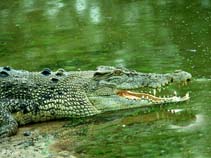Crocodylus porosus Schneider, 1801
Estuarine crocodile| Native range | All suitable habitat | Point map | Year 2050 |

|
| This map was computer-generated and has not yet been reviewed. |
| Crocodylus porosus AquaMaps Data sources: GBIF OBIS |
Классификация / Names народные названия | синонимы | CoL | ITIS | WoRMS
Reptilia | Crocodilia | Crocodylidae
Environment: milieu / climate zone / пределы глубины / distribution range экология
пелагический; мигрирует в океане (ссылка 77091); пресноводный; пределы глубины 0 - 200 m. Tropical; 41°N - 36°S, 77°E - 171°E (ссылка 356)
Distribution страны | регионы FAO | Ecosystems | места находок | интродукции
Indo-West Pacific.
Length at first maturity / Size / Weight / Возраст
половая зрелость: Lm 110.0 range ? - ? cm Max length : 615 cm TL самец/пол неопределен; (ссылка 77094)
Краткое описание морфология
Large head and strong snout with a pair of ridges bridging the orbits. Uniform dorsal scales. Very variable coloration. Juveniles with black bands and spots. Body with 4-5 black bands which may disappear in very large individuals. The belly is uniformly colored beige to golden yellow. Some individuals maybe highly pigmented.
May cross open ocean as evidenced by occurrence in remote islands in the Indian Ocean and in the western Pacific Ocean (salinity range 5-20 per mille). Inhabits a wide range of habitats (rivers, creeks, swamps, lagoons and billabongs); needs a source of water less salty than their blood (blood plasma salinity of 11per mille). Ref. 77096 reports a maximum length of 700 cm total length and a maximum weight of 1000 kg for captive individuals. Often basks on open mud banks in cooler months and often in the shade of mangrove areas in warmer months. Has a strong homing ability. Oceanodromous individuals may have barnacles attached to their scales (Ref. 77096). May also have endoparasites, i.e., round worms, tongue worms and flukes (Ref. 77091). Crocodile eggs and flesh are food for humans, while crocodile skin (notably near the belly) are used by the leather industry mostly from farmed crocodiles (Ref. 77091). Known to attack humans, sometimes fatally (Ref. 077096, 077099). Active throughout the year. Hunts by day and night; hunting probably associated to diving behavior. Size determines feeding, i.e., small crocodiles feed frequently on small prey items while larger crocodiles feed infrequently on larger prey. May consume carrion. Gastroliths (stomach stones) help in digesting food items (Ref. 77091).
Life cycle and mating behavior половая зрелость | размножение | нерест | Eggs | Fecundity | Larvae
Основная ссылка
ссылки | координатор | соавторы
Greer, A.E. 2006. (ссылка 77091)
Статус Красного Списка МСОП
(ссылка 130435: Version 2024-2)
Не вызывающий беспокойства (LC) ; Date assessed: 14 November 2019
Статус СИТЕС (ссылка 108899)
Appendix I: International trade banned
CMS (ссылка 116361)
Appendix II: Migratory species conserved through agreements
Угроза для людей
Traumatogenic (ссылка 77096)
Использование человеком
рыболовство: коммерческий; аквакультура (рыбоводство): коммерческий
FAO - рыболовство: landings | FishSource | Sea Around Us
инструменты
дополнительная информация
Trophic Ecology
экология
Population dynamics
рост
Max. ages / sizes
Length-weight rel.
Length-length rel.
Размерный состав
Mass conversion
пополнение
численность
Max. ages / sizes
Length-weight rel.
Length-length rel.
Размерный состав
Mass conversion
пополнение
численность
Life cycle
Human Related
Aquaculture profiles
Stamps, coins, misc.
Stamps, coins, misc.
Outreach
ссылки
ресурсы в Интернет
BHL | BOLD Systems | CISTI | DiscoverLife | FAO(рыболовство: ; publication : search) | Fishipedia | GenBank (Геном, Нуклеотид) | GloBI | Gomexsi | Google Books | Google Scholar | Google | PubMed | Tree of Life | Wikipedia (Вперёд, поиск) | Zoological Record
Estimates based on models
Preferred temperature
(Ref. 115969): 24.2 - 29.1, mean 28.1 (based on 3318 cells).
устойчивость к внешним воздействиям
(Ref. 69278):
высокий, минимальное время удвоения популяции до 15 месяцев (K=0.71-2.5).
Категория цены
(ссылка 80766):
Unknown.



